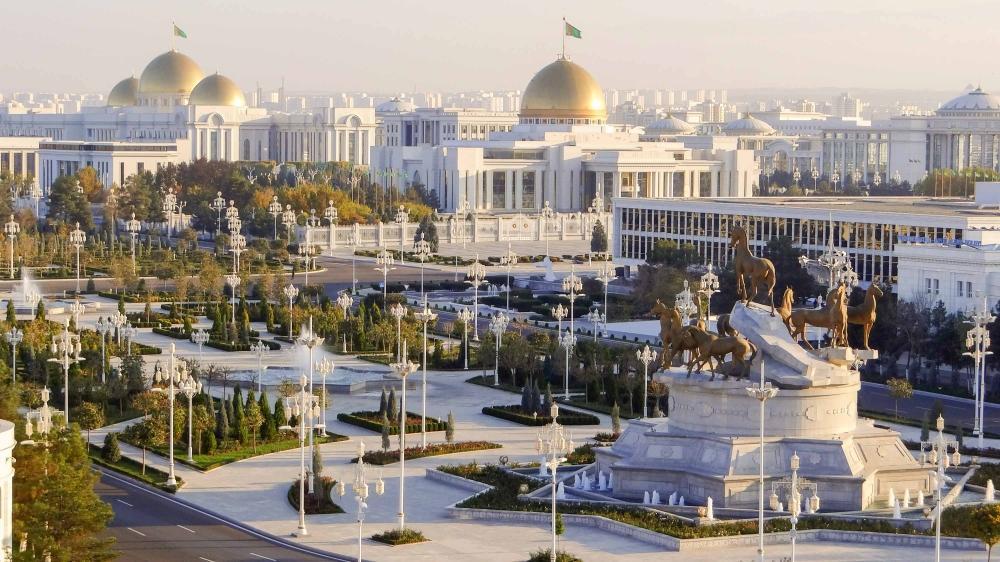Africa-Press – Rwanda. Rwanda and Turkmenistan, a country in Central Asia bordered by the Caspian Sea and largely covered by the Karakum Desert, on Monday, July 14 announced the formal establishment of diplomatic relations, marking the beginning of a new chapter in bilateral cooperation and mutual engagement.
With a population of about 7.6 million people on a land area of 491,210 square kilometres – 70% desert – Turkmenistan, one of the most fascinating countries in Central Asia, is a country with a unique blend of natural wonders, historical sites, and distinctive cultural traditions.
Here are 10 fascinating things about Turkmenistan:
1. Traditional clothing and carpets
Turkmenistan is best known for its carpets which carry the memory of past centuries in their unique patterns. Turkmen carpets are UNESCO-recognized for their cultural importance and craftsmanship. Turkmen women often wear traditional dresses and jewellery, and national identity is closely tied to textile patterns, which also appear on the national flag.
Turkmen carpets have UNESCO Intangible Cultural Heritage status. Each tribe has its own distinctive design.
2. The ‘Door to Hell’ – Darvaza Gas Crater
Turkmenistan is home to the Darvaza gas crater, a massive burning pit in the middle of the Karakum Desert.
The crater located about 260 kilometres north of Ashgabat, the capital of Turkmenistan, has been on fire since 1971 when a Soviet drilling accident released natural gas.
It is reported that geologists set it alight to prevent gas leaks, expecting it to burn out quickly — it never did.
3. Ashgabat – The white marble capital
The capital city, Ashgabat, holds the Guinness World Record for the highest concentration of white marble buildings and grandiose national monuments in the world. The architecture is magnificent, modern, and often dreamlike, a result of major state-led urban development.
4. Neutrality as national policy
Turkmenistan is recognized by the UN as a permanently neutral country — one of the very few nations in the world with such a status. This status was formally recognized by the UN General Assembly on December 12, 1995.
The country, it is reported, avoids joining military alliances or taking sides in regional conflicts.
On March 21, during the 61st plenary meeting of the 79th session of the UN General Assembly, the Resolution “Permanent Neutrality of Turkmenistan” was adopted under Agenda item 61 “Peacebuilding and Peacekeeping” by consensus.
5. Traditional horse: The Akhal-Teke
The Akhal-Teke is a Turkmen horse breed prized for its beauty and endurance. It is known for its metallic sheen and incredible endurance and is considered a national treasure and symbol of Turkmen pride.
Akhal-Teke Horses are some of the oldest and most unique horse breeds in the world.
6. Huge natural gas reserves
Turkmenistan holds the fourth-largest natural gas reserves in the world. The country is estimated to possess around 10% of global natural gas reserves which are primarily located in the Galkynysh field, one of the largest gas deposits globally.
7. The Karakum Desert
Covering over 70% of the country, the Karakum Desert is one of the driest places on earth and home to the Darvaza crater and rare desert wildlife. Despite the harsh climate, animals like the goitered gazelle, jerboas, and various reptiles, including snakes and lizards, inhabit the area. The desert also supports unique bird species and mammals adapted to its arid conditions.
8. No smoking in public
According to the World Health Organisation (WHO), all enclosed public places are completely smoke-free in Turkmenistan. The country has one of the strictest anti-smoking regimes in the world, with comprehensive bans on smoking in public places, tobacco advertising, and even the sale of tobacco products.
9. Melon festival
Turkmen melons are so famous – so sweet, juicy and large. Turkmenistan celebrates a national holiday dedicated to melons, acknowledging their importance to the country’s agriculture.
10. Plov is the favourite dish in Turkmenistan
Turkmenistan is a country with a rich culture and traditions. One of the significant parts of this culture is the cuisine.
Composed of mounds of rice mixed with meat, carrots, and spices fried in a large pan, plov (which is like a pilau) can be found everywhere in Turkmenistan — from intimate family picnics at sacred sites to grand wedding celebrations. Often considered a national dish, plov is cooked in large cauldrons, often over an open fire.
For More News And Analysis About Rwanda Follow Africa-Press






